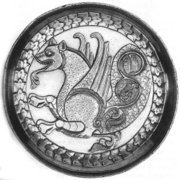Senmurv — Simurgh Pièce de soie Sassanide d un Simurgh entouré de perles, environ VIe VIIe siècle ap. J. C. Simurgh (en Persan سيمرغ ) ou Sênmurw en Moyen persan (Pahlavi) aussi connu sous le nom de Sîna Mrû (Pâzand), est un oiseau mythique et fa … Wikipédia en Français
Iranische Mythologie — Das Gebiet der Entstehung der iranischen Mythologie und die wesentliche Region ihres kulturellen Wirkens umschließen insbesondere den heutigen Iran, Afghanistan, Tadschikistan, Mesopotamien sowie Kurdistan, den Kaukasus, Belutschistan und Teile… … Deutsch Wikipedia
Représentation figurée dans les arts de l'Islam — Élément de décoration d une copie du De Materia Medica de Dioscoride, 1229, Syrie L histoire de la représentation figurée dans les arts de l Islam est un problème complexe, à l intersection de facteurs religieux, sociaux, politiques et… … Wikipédia en Français
Chamrosh — is a bird in Persian mythology said to live on the summit of Mount Alborz. Chamrosh is described as having the body of a dog with the head and wings of a bird. It was said to inhabit the ground beneath the soma tree that was the roost of the… … Wikipedia
Phoenix (mythology) — The phoenix (Ancient Greek: Φοῖνιξ, phoínix) is a mythical sacred firebird in ancient mythologies starting with the Greek and later the Egyptian and the Phoenician mythology. Appearance and Abilities A phoenix is a mythical bird with a tail of… … Wikipedia
Simurgh — or Simorgh ( fa. سیمرغ), sometimes spelled Simurg or Simoorg , also known as Angha ( fa. عنقا), is the modern Persian name for a fabulous, benevolent, mythical flying creature. The figure can be found in all periods of Greater Iranian art and… … Wikipedia
Dacian Draco — as from Trajan s Column The Dacian Draco was the standard and ensign of troops of the ancient Eastern European Dacian people, which can be seen in the hands of the soldiers of Decebalus in several scenes depicted on Trajan s Column in Rome, Italy … Wikipedia
List of Dungeons & Dragons 3.0 edition monsters — See also: List of Dungeons Dragons monsters Dungeons Dragons version 3.0 (see editions of Dungeons Dragons) was released in 2000. The first book containing monsters to be published was the Monster Manual, released along with the other two core… … Wikipedia
Hindukusch — p1 Hindukusch Hindukusch Höchster Gipfel Tirich Mir (7.708 m) … Deutsch Wikipedia
Saena-Baum — Der Simurgh Baum (in der Avesta als Saena Baum bekannt) ist in der Iranischen Mythologie die Mutter aller Bäume , welche in der Mitte des Meeres wuchs. Dieser soll der Ursprung aller Pflanzen sein. Zuweilen wird er auch als Baum jeder Heilung… … Deutsch Wikipedia
 Der Schutzvogel Simurgh auf einer vergoldeten Silberschale (späte sassanidische Zeit, 7.-8. Jh. n. Chr.)
Der Schutzvogel Simurgh auf einer vergoldeten Silberschale (späte sassanidische Zeit, 7.-8. Jh. n. Chr.)